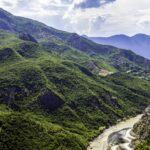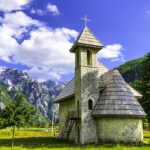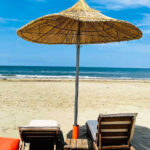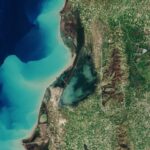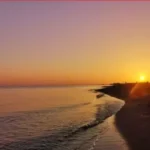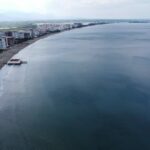National Parks of Albania
National Parks in Albania
This is the natural crown of Albania, which ranks us among the few countries in Europe with the Alps. The Albanides are the last continuation of the Dinaric Alps and their culmination, since here lies their highest peak, the majestic Jezerca (2,694 m). The park has united the natural ecosystems of Valbona Valley and Theth declared a national park, and Gashi River declared a strict natural reserve. Ernest Koliqi, perhaps the most brilliant of our romantic writers, has famously said that in our mountains love and death are often synonymous. This may be true as our Alps are commonly referred to as the Accursed Mountains. The contrasts of the landscapes, as a result of the isolated relief with diverse characteristics, give the entire park a spectacular, truly striking appearance, capable of leaving you speechless. The Valbona Valley, known as the pearl of the north, is a rare tourist phenomenon for Albania, as is Thethi, the village that preserves in modern Albania, almost petrified, the atmosphere of the highlanders’ life, as well as bears the evidence of the blood feuds, to show us one of the rarest canonical phenomena of Europe, but also to teach us why history should not repeat itself. The Alpine National Park offers the possibility of an unparalleled experience where you can enjoy the stunning beauty of nature, the mountain lifestyle, hiking, organized tours, and mountaineering. National Parks of Albania
How to get there: Travel from Tirana to Kukës, then from Kukës to Valbona Valley. From there you can navigate to the other parts of the park.
Lurë – Mali i Dejës National Park
When you hear the name, Lura, you probably think immediately of the 12 glacial lakes of Lura, known as “Lura’s Crown Lakes”, a unique grouping of these water masses with a rare beauty that surprisingly has inspired artists from time to time, among them Ismail Kadare who writes: “No one can separate Lura from its lakes. Therefore, whoever travels to Lura, travels to its lakes…Suddenly we see the lakes, one after the other, greener than blue surrounded by mountains and pines. As always, when you are in front of beautiful things, it is difficult to describe them. Words are pale in front of the water and greenery that make up all those shades of this living beauty.” Sights that visitors urge not to be missed are the broad-leaved white lilies over the lake or the gorgeous meadows. The mountainous relief that culminates with the peak of Deja (2,246 m) and centuries-old forests give a mystical feeling to this area. The atmosphere of the smoky peaks and the icy beauty of the glacial valleys are the first taste of the natural world of Northern Albania. The aesthetic qualities of the landscapes of this park are among the most important values it is known for. For those of you who would love a trip to lands that resemble folk tales, this is the best opportunity you will get.
How to get there: You can reach it by following the Peshkopi – Fushë Lurë rural road.
Dajti National Park
Dajti National Park is located in the central part of the Krujë-Dajt mountain range, northeast of Tirana. This park is known as a large and diverse ecosystem, almost untouched by man, and well preserved. It serves as the home of 668 different species of animals, and an endless variety of plants, four of them typical for this country. Covered by diverse flora, the park changes its appearance with the seasons and all its views are impressive. Such proximity to the capital makes Mount Dajti and the park a favorite spot where families go for picnics, and tourists to enjoy some fabulous views of Tirana, but there are plenty of other things you can do. The park is known for its cable car, unique for Albania, which not only provides a wonderful experience but also has a rich history. As one of the most populated parks in the country, Dajti offers in certain areas opportunities for mountaineering, skiing, etc. From there you can also see the Adriatic Sea. Mussel fossils have been found here, which proves the orogenic movement activity and shows that centuries ago this territory was bordered by the sea. The good and quite healthy climate is another reason why the park is widely preferred for recreation.
How to get there: You can go to Dajti Mountain by following the road or by cable car.
Shebenik National Park
Magnificent and full of greenery, Shebenik seems to have a joyful nature, with a good and warm climate, it seems as if it invites you to visit. It is a cross-border area with the Republic of North Macedonia, in the Southeast Region of the country, near Librazhd. It is considered one of the most complex natural ecosystems, part of the green belt of Europe, with some of the most magnificent mountain landscapes in the Balkans. The friendly temperament of the locals and the Central Albanian culture have given the area a good name and during your time in the park you can enjoy the local hospitality and cuisine in some of the houses turned into taverns. Lovers of mountain tourism choose Shebenik Park in large numbers for the various possibilities it provides. Be careful, you may encounter tigers on the way, although it is unlikely. We are talking about the Balkan tiger, the lynx, the legendary cat that is now on the red list in danger of extinction. Mountaineering is the best activity you can do in Shebenik National Park.
How to get there: From the north, from Peshkopia or Dibra, you can reach Peshkopi-Librazhd road at the entrance of Stërblevë village, or continue to the entrances below. From Tirana, Elbasan, or the west, the park can be reached by the Tirana-Skopje highway
National Parks of Albania
Divjakë-Karavasta National Park
Divjakë-Karavasta National Park is a protected area in the coastal area of Albania, it consists of complex ecosystems, very rich in diversity and natural resources. It is, without a doubt, the most important protected area along the Albanian coastal space, even among the most important on the shores of the Mediterranean. It stretches like a green arc on the side of the Adriatic Sea, it is located about 5 km from the city of Divjaka and about 70 km from Tirana. The wide gallery of landscapes, and species, many of which are endangered, give the Divjakë-Karavasta Park the role of a natural cell in the heart of the coast, responsible for the creation and development of a fragile life with special cultural, scientific, and historical importance and values. Divjaka is also known as a beach tourist area, so the opportunity to spend a day full of activities naturally presents itself. However, we believe that one day will be enough for you to experience the park’s beauty and rare peaceful energy. The park is also known for the Karavasta Lagoon, the largest in the country, the residence of a charming pelican (Dalmatian Pelican), and many other species. Visiting the park offers a great opportunity to try local cuisine and traditional crafts.
How to get there: The road leading to the Divjakë – Karavasta National Park has been completely rehabilitated. From Tirana you have to take the highway to Durrës and then, from there, take it to Fier. Then, after about 38 kilometers, follow the signs for Çerma and then those for Divjaka.
National Parks of Albania
Prespa National Park
It is located on the border of Albania, Greece, and North Macedonia and is a natural continuation of the Prespa National Park in Greece and the Galicica National Park in North Macedonia. It includes the Great and Small Prespa lakes and their surrounding territories. According to the tripartite agreement, between the three coastal countries, at the same time, it is a cross-border park. Within this ecosystem, there are 22 types of habitats and we also find the Lynx here. The lakes of Prespa have a tectonic origin, the waters of the big lake are clear and their depth reaches up to 54 meters. Besides the opportunity to enjoy delicate landscapes, you can visit the island of snakes, Malingrad, which is located in the Albanian part of the park. The church on the island dates back to the 14th century. Also known for the area’s cave dwellers, the park has a large number of bats.
How to get there: If you travel from Tirana, take a public bus to Korça at the bus station near the Faculty of Economics. This bus takes you to the bus station in Korça where you can take one of the two public buses that travel to Prespa National Park. If you travel through Macedonia to get to Prespa National Park, there is a border crossing in Stenje and after 5 km you’ll get to the center of the park.
National Parks of Albania
Tomorr National Park
Mount Tomorr is located east of the city of Berat and Poliçan, south-southeast of Çorovoda, west of Gramsh, and in the northernmost part of the mountain range Tomorr-Kulmak-Miçan. In the Albanian cultural world, Mount Tomorri has a special place as a pilgrimage point, it is seen as a symbol of nature, a place with marked uniqueness and special energies. A natural temple of pantheism, on top of it you can find cult monuments such as Teqeja e Kulmaku, where mostly Bektash believers continue to preserve the traditions. Its religious qualities go way further back in history, the mountain is mentioned by ancient Greek sources as a sacred place of pagan rituals and in certain documents, it also appears as a mythological mountain, from where Zeus occasionally threw his thunderbolts. With rare and very rich biodiversity, the plant elements of the Mediterranean and Alpine biogeographic zones are mixed in this park. Inside the park, there are natural monuments of fresh beauty, such as the Sotira Waterfall, the Bogova Waterfall, the Tomorri Glacier Cirques, and, the Kapinova Cave, all of which are worth visiting. In the park you can do trekking, cycling, rock climbing, horseback riding, and even during the winter, the park offers very good mountaineering opportunities.
How to get there: From Tirana travel towards Elbasan. Then from Elbasan take the road to Berat. Once you arrive in Berat, go to Poliçan and from there the signage will help you arrive at the park.
National Parks of Albania
Bredhi i Hotovës – Dangëlli National Park
Renowned as the natural lung of Southern Albania, Bredhi i Hotovës – Dangëlli National Park is the largest in the country, at well as the largest forestall forestal; crown in the south. The natural-historical values of the park are represented by the predominance of the Macedonian Fir, a Mediterranean relict species. For all aficionados of trekking, the park offers five different itineraries, the area is also ideal for mountain biking, and 4×4 cars (the most frequented itinerary is Përmet-Frashër-Ogren-Bënjë-Përmet). During the itineraries, it is possible to visit several villages in the area, including Frashëri, where you can stop at the house museum of the Frashëri brothers, the most famous illuminist trio of the Albanian National Renaissance period (1831-1912). The road can take you to the Kamenica Canyon, or the Langarica Canyon, both with idyllic beauty. The interior of the park testifies to the early and rich culture of the area, the cultural and historical monuments such as the church of Saint Mary in Okdunan and Kosina, Teqeja of Ali Postivan, and Frashëri, Ura e Katiu, etc. serve as evidence. In winter, visitors say that the snow lends an almost fairy-tale naive beauty to the park, and bearing in mind that the heights go up to 1,600 meters, it must be quite a sight.
How to go: Departure from Tirana. Walk on the Tirana – Elbasan highway. Continue the road to Gjirokastra. The signs will guide you to arrive at the destination.
National Parks of Albania
Karaburun-Sazan National Park
This is the only national marine park, the case of a rich marine aquatic ecosystem, home to 36 marine species of international importance. It extends in the maritime space with a width of 1 nautical mile, along the Karaburun Peninsula and around Sazan Island. The whole area of the park is an amalgamation of fantastic seascapes, underwater caves, bays with peculiar names, and a fantastic opportunity to spend a beautiful time with friends or family. The whole area stands out as one of the most beautiful sea oases in the Mediterranean Sea. The park is often visited by emblematic marine species, such as Mediterranean Seals or Dolphins. It seems that this park attracts more and more tourists, especially during the summer season, as it offers the possibility of boat trips, visiting and exploring underwater caves with safety measures and of course, beaching under the Mediterranean sun, which probably serves as an experience most characteristic of this area. There are also very interesting elements of history and material culture, which you will find underwater, in the form of the remains of ancient Illyrian, Greek, but also medieval or modern ships. Above the water, better to say on the shore, you can see engravings of ancient fishermen and sailors on the rocks. The park is of particular importance and since 2015 is part of the Specially Protected Areas in the Mediterranean, according to the Barcelona Convention. The Karaburun-Sazan National Park is Albania’s maritime fairy tale.
How to get there: From Tirana go towards Elbasan, and from Elbasan follow the road towards Vlora. In Vlora, follow the signs.
National Parks of Albania
Vjosa National Park
Albania’s newest national park, the Vjosa River National Park represents a worldwide phenomenon of the will of environmentalists and experts to preserve one of Europe’s last wild rivers and is the first and only wild river to hold the status of a national park in Europe. The Vjosa and its main branches flow freely for over 400 km, from the Pindis mountain range in Greece, where it is called Aoös, to the Adriatic coast in Albania. It is part of the UNESCO World Cultural Heritage Site list and is home to over 1,000 species, 13 of which are globally endangered. Vjosa is a bold testimony of the coexistence of people, cultures, and nature for more than 2400 years. The stunning views of the valley are not to be missed. You can enjoy the park by rafting, hiking, or even climbing. Be sure to also try the fantastic dishes of the area
National Parks of Albania
Llogara National Park
This is probably the most famous park in Albania, a solemn natural monument that unites all the plant areas of the country, creating mixed landscapes of Mediterranean forests, but also of alpine pastures. It is located approximately 40 km southeast of the city of Vlora, on the border between the Adriatic and Ionian seas. It stands out for its rare natural beauty and the extraordinary panorama of the Ionian Sea, and it has even been called “the balcony with the most beautiful view in Albania”, thus referring to the Llogara Pass. Llogara National Park represents one of the richest and most special areas of biological diversity, with 15 types of habitats, most of which are protected at the international level. For many Albanians, this area is a source of memories, as for years it has served as an irreplaceable axis on the way to summer vacations, for the majority of southern destinations. The symbol of the area, among others, is the Flag pine, a pine over 100 years old, which the strong winds have bent, giving it the silhouette of a waving flag. Llogaraja, but also Mount of Çika (2044 m) are part of the Acroceraunian ranges, in ancient times the northern border of the State of Epirus. In recent years air sports (especially paragliding) and mountain biking have been added as some of the most popular visitor activities. During winter, the park offers spectacular views of snow and frosting beauty.
How to get there: The best way is to follow the Fier-Saranda Road. If you travel by bus, you can take a bus from Tirana to Vlora and then a special van from Vlora to Llogara.
National Parks of Albania
Butrint National Park
Yes, this is Butrint of the “Twelfth Night”, otherwise known, as one of the favorite resting places for the Greco-Roman aristocracy of ancient times. It is located 25 km from the city of Saranda and extends from the shores of the Ionian Sea of the Delvina field. For the combination of the diverse natural landscapes with the remains and ancient artifacts of the Greco-Roman culture, Butrint enjoys the status of a golden name in the history of Albanian archaeology, the historical part is part of UNESCO since 1999, while the lake of Butrint is an Area Specially Protected, according to the Barcelona Convention of 1995. In other words, the park is a great fortune for Albania. Here you can even see large blocks with Pelasgian inscriptions. Observing the historical points and enjoying the natural beauty are undoubtedly the primary and most important activities when visiting Butrint. If you are lucky, you may come across dolphins or sea turtles on the shores. About 35 species of globally threatened animals live in the habitats of this park. Inside the park is the main Archaeological center of Butrint, while around it other monuments testify to a civilization over 3000 years old.
How to get there: We recommend you follow the Sarandë-Ksamil national road. Departure from Tirana.
